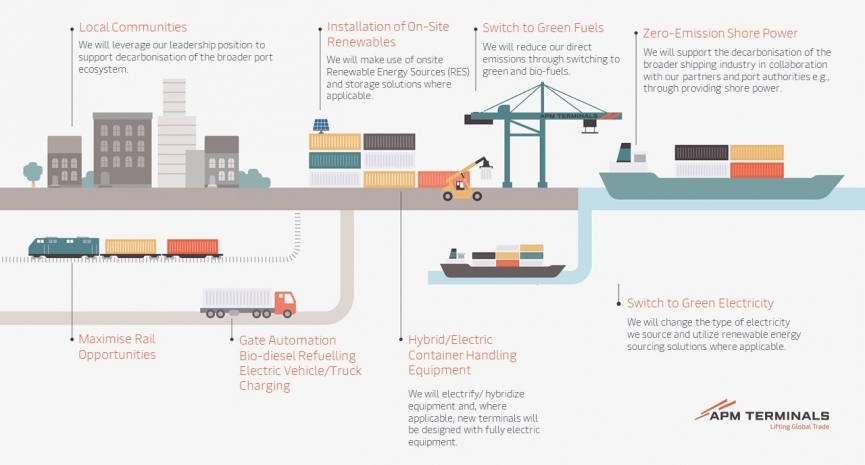APM Terminals to achieve net zero greenhouse gas emission target in 2040
Two new solar arrays installed in January 2022 at APM Terminals Barcelona are the first of five planned as part of an ambitious project that will provide 5.12 percent of the energy used by the terminal. The remaining electricity used at the terminal is supplied from renewable sources.

January 15, 2022: Two new solar arrays installed in January 2022 at APM Terminals Barcelona are the first of five planned as part of an ambitious project that will provide 5.12 percent of the energy used by the terminal. The remaining electricity used at the terminal is supplied from renewable sources.
APM Terminals will bring forward its Net Zero greenhouse gas emission target to 2040, a decade ahead of its initial 2050 ambition. A 70 percent reduction in absolute (total) emissions has been set as an interim milestone for the period 2020-2030.
This is the most ambitious target set by any terminal operator to date.
This commitment builds upon the company’s existing strategic approach to decarbonisation and recent investment in a full suite of solutions to reduce its carbon footprint. It will also contribute to a broader target set by parent company A.P. Moller - Maersk to achieve net zero greenhouse gas emissions in 2040 across all business entities.
Science-Based Targets
The Net Zero criteria use the Science Based Targets initiative (SBTi) pathway to limit global warming to 1.5°C. They include a societal commitment to act now and drive material impact in this decade, and a commitment to deliver net zero supply chains to customers by 2040.
“We have detailed plans to achieve this absolute reduction, supported by our dedicated Head of Decarbonization for APM Terminals, Sahar Rashidbeigi appointed in November last year,” says APM Terminals Chief Operating Officer, Keith Svendsen.“
As recommended by SBTi, over the decade APM Terminals and the Maersk Group will go above and beyond the 1.5°C aligned targets and invest in building a portfolio of natural climate solutions that will result in around five million tons of CO2 savings per year by 2030.
“Looking at our carbon footprint, we want to address both fuel-based emissions, as well as those from the generation of purchased electricity, and we will also work with customers, suppliers and partners to involve them in this, because we believe this issue needs to be tackled holistically,” explains Svendsen.
How will APM Terminals achieve Net Zero Emissions?
Energy Consumption Optimisation
APM Terminals has developed a decarbonisation roadmap, with a range of focus areas, he explains as he talks about some of the main initiatives. “Through energy consumption optimisation we will continuously reduce fuel and electricity consumption across the entire terminal ecosystem. We will improve our electricity sourcing and change the type of electricity we procure, utilizing renewable energy solutions whenever possible. We will also focus on alternative fuels and reduce our direct emission through transition towards emission free fuels.
“Eliminating emissions will sometimes require developing green energy alternatives in locations where such options are currently not available. We see our role as a trusted infrastructure partner rather than just moving boxes, and we will work with our local and national governmental partners to enable the development of necessary infrastructure that will benefit a wide spectrum of players who opt for green energy and/or fuel alternatives. This will not only drive the local climate agenda, but also create jobs and new business opportunities. In APM Terminals we will also initiate a dialogue with main energy providers to source for alternative fuels in locations where that is currently not possible as well as engage with our main equipment producers to develop equipment compatible with the requirements for alternative fuel.”
Maintaining Competitiveness
For customers, the most important requirement is that transport solutions are competitive, reliable, and offer an increasingly low environmental impact. Through pilot programmes already run by APM Terminals, such as the Green Gothenburg Gateway, and careful analysis, the company is confident that sustainable solutions also support all of these requirements.
In the intermodal area between landside logistics and ocean freight, through these new targets, APM Terminals will be ideally positioned to offer its shipping line customers, freight forwarders, and cargo owners an unparalleled opportunity to decarbonise their logistics chains on an end-to-end basis.


